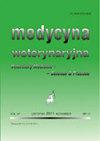土耳其马和驴中选定寄生虫和病毒感染的发生情况
IF 0.4
4区 农林科学
Q4 VETERINARY SCIENCES
Medycyna Weterynaryjna-Veterinary Medicine-Science and Practice
Pub Date : 2023-01-01
DOI:10.21521/mw.6743
引用次数: 0
摘要
本研究旨在调查土耳其Balikesir及其周边地区马科动物中某些原生动物(卡巴利贝氏杆菌、马弓形虫、刚地弓形虫、新孢子虫等)和病毒因子(马流感、马病毒性动脉炎、马疱疹病毒)的流行情况。采集了66匹马和96头驴的血浆和血清样本。c-ELISA法检测卡巴贝斯虫、马氏弓形虫和新孢子虫抗体,Sabin Feldman Dye法检测弓形虫抗体。采用PCR技术检测病毒因子。马体内原虫感染率分别为:卡巴利布氏杆菌12.12%、马弓形虫34.84%、弓形虫9.09%、新孢子虫10.6%;马流感病毒和马疱疹病毒5型的分子流行率分别为3.03%和6.06%。在所有样本中均未检测到马病毒性动脉炎病毒和其他疱疹病毒(1、2和4)。毛驴血清阳性率分别为:卡巴利布氏杆菌1.69%、马弓形虫71.87%、弓形虫90.62%、新孢子虫23.95%、马流感病毒1.04%、马病毒性动脉炎病毒0%、马5型疱疹病毒3.12%、其他疱疹病毒0%。本研究首次报道了土耳其西部安纳托利亚地区驴中存在抗新孢子虫抗体,以及马和驴中弓形虫的血清阳性率。本文章由计算机程序翻译,如有差异,请以英文原文为准。
Occurrence of the selected parasites and viral infections in horses and donkeys in Turkey
The present study aimed to investigate the prevalence of certain protozoa (B. caballi, T. equi, T. gondii, Neospora sp.) and viral agents (equine influenza, equine viral arteritis, equine herpesviruses) of equids in Balikesir and its surroundings, in Turkey. Plasma and serum samples were collected from 66 horses and 96 donkeys. Babesia caballi, T. equi and Neospora sp. antibodies were detected with c-ELISA, whereas T. gondii antibodies were revealed by the Sabin Feldman Dye test. Viral agents were detected by the PCR technique. The prevalence rates of the protozoa in horses were 12.12% for B. caballi, 34.84% for T. equi, 9.09% for T. gondii, and 10.6% for Neospora sp. The molecular prevalence of the viral agents amounted to 3.03% for equine influenza virus and 6.06% for equine herpesvirus 5. Equine viral arteritis virus and other herpesviruses (1, 2 and 4) were not detected in any of the samples. The rates of seropositivity in donkeys were 1.69% for B. caballi, 71.87% for T. equi, 90.62% for T. gondii, 23.95% for Neospora sp., 1.04% for equine influenza virus, 0% for equine viral arteritis virus, 3.12% for equine herpesvirus 5, and 0% for other herpesviruses. This study is the first to report the existence of anti-Neospora sp. antibodies in donkeys and the seroprevalence of T. gondii in horses and donkeys in Western Anatolia, Turkey.
求助全文
通过发布文献求助,成功后即可免费获取论文全文。
去求助
来源期刊

Medycyna Weterynaryjna-Veterinary Medicine-Science and Practice
VETERINARY SCIENCES-
CiteScore
0.80
自引率
0.00%
发文量
73
审稿时长
4-8 weeks
期刊介绍:
"Medycyna Weterynaryjna" publishes various types of articles which are grouped in the following editorial categories: reviews, original studies, scientific and professional problems, the history of veterinary medicine, posthumous memoirs, as well as chronicles that briefly relate scientific advances and developments in the veterinary profession and medicine. The most important are the first two categories, which are published with short summaries in English. Moreover, from 2001 the editors of "Medycyna Weterynaryjna", bearing in mind market demands, has also started publishing entire works in English. Since 2008 the periodical has appeared in an electronic version. The following are available in this version: summaries of studies published from 1999 to 2005, full versions of all the studies published in the years 2006-2011 (in pdf files), and full versions of the English studies published in the current year (pdf). Only summaries of the remaining studies from the current year are available. In accordance with the principles accepted by the editors, the full versions of these texts will not be made available until next year.
All articles are evaluated twice by leading Polish scientists and professionals before they are considered for publication. For years now "Medycyna Weterynaryjna" has maintained a high standard thanks to this system. The review articles are actually succinct monographs dealing with specific scientific and professional problems that are based on the most recent findings. Original works have a particular value, since they present research carried out in Polish and international scientific centers.
 求助内容:
求助内容: 应助结果提醒方式:
应助结果提醒方式:


